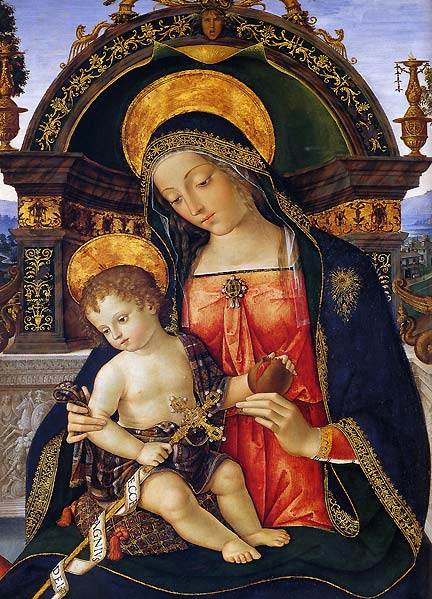FINDING MARY IN THE SCRIPTURES – Part VI
Fr. James McMillan, SMM
FINDING MARY . . .
Woman of Faith
St. Luke, the author of the third gospel and of the Acts of the Apostles, . . .
. . . has occasionally been referred to as the evangelist of the Blessed Virgin Mary. It is a title that can, in a sense, be justified. But it can just as easily be misunderstood.
The title makes sense if we bear in mind that St. Luke, who asserts plainly that he wrote his gospel from the testimony of eyewitnesses, could have received his information for the so-called Infancy Narrative only from our Blessed Lady. No one else could have supplied any eye-witness data about the Annunciation, the Visitation, the birth of Christ, the coming of the shepherds and the Wise Men from the East.
St. Luke, the Evangelist of the Blessed Virgin Mary.
But the title can be misunderstood and falsified if we take it to mean that anyone but Christ Himself is the center, the focal point of the Gospels, including the narrative of St. Luke. All the gospels are concerned exclusively with Christ the Redeemer and with the redemption He came to bring us. Christ alone is the pivotal figure – the sole protagonist, as literary people say – in the gospels, and He alone is presented by the writers as the Messiah and the Redeemer.
Everyone else in the gospels has a subordinate role to play, and this includes our Blessed Lady. The word “subordinate,” however, does not mean unimportant. Christ chose to make others share somehow in the work of redemption which He alone effected. We have only to think of John the Baptist, St. Joseph, and the Apostles (to name but a few) to realize that the redemption includes many who cooperated with Christ in some way or another.
This is especially true of our Blessed Lady. Of all the subordinate roles, hers is undoubtedly the most important of all. Christ chose her as His associate and cooperator in the redemption of the human race.
Our Lady’s first appearance in the gospel of St. Luke comes in his narrative of the Incarnation.
“In the sixth month, the angel Gabriel was sent by God to a town of Galilee called Nazareth, to a virgin espoused to a man named Joseph of the house of David. And the virgin’s name was Mary . . . “.
Contrasting the Faith
This annunciation, as we call it, is not the first one presented by St. Luke. It was preceded by an appearance of the same angel Gabriel to “. . . a priest called Zachary . . . who had married a wife of Aaron’s family by the name Of Elizabeth. They were both well approved in God’s sight . . . They had no child; Elizabeth was barren, and both were now well advanced in years.” The angel tells Zachary that he and Elizabeth are to have a son, to whom he was to give the name John. The angel explains what John was to do: “He shall unite the hearts of all . . . preparing for the Lord a people fit to receive Him.”

Madonna and Child: Italian Painter: Pinturicchio (1454-1513)
Also known as Pintoricchio or Pinturicchio. His formal name was Bernardino di Betto, also known as Benetto di Biagio or Sordicchio.
Unlike Zachary, the virgin of Nazareth freely accepted what God wanted her to do. She freely acceded to God’s wish that she become the Mother of the Redeemer. For this, the Church salutes her as the Woman of Faith.
Return to The Queen: Articles
St. Luke recounted these two annunciations with the undoubted purpose of contrasting the faith and willingness of Our Lady with the skepticism and doubt of Zachary.
Zachary demands a sign, some proof of the angel’s words: “By what sign am I to be assured of this? I am an old man now, and my wife is far advanced in age.” Perhaps it is not possible for an angel to be annoyed, to feel that his word is being slighted. But that is exactly the way Gabriel reacts to Zachary’s doubts. “My name,” he says, “is Gabriel, and I stand before God. I have been sent to speak with you, to bring you this good news.” And then, as if to say: “If you want a sign, I’ll give you one,” the angel Gabriel tells Zachary that he will be dumb, have no power of speech, until the child is born.
The Annunciations
Zachary’s doubt is contrasted with Our Lady’s faith in the second annunciation given by Gabriel, this time to the virgin of Nazareth. She does not demand a sign from God; she simply asks what she is to do: “How shall this be, since I do not know man?” Gabriel explains to her: “Behold, you shall conceive in your womb, and shall bear a Son and you shall call Him Jesus.” The angel then speaks of this Son by using all the wellknown titles that refer to the coming Messiah. He shall be great, the Son of the Most High, possessing the throne of His ancestor David. He is to reign over the house of Jacob forever, and His Kingdom shall have no end.
Gabriel explains how this shall come about through the power of the Most High, that the Holy Spirit will come upon her and that her child shall be known as the Son of God. He informs her that her cousin Elizabeth is now in her sixth month “. . . to prove that nothing is impossible with God.”
Unlike Zachary, the virgin of Nazareth freely accepted what God wanted her to do. She freely acceded to God’s wish that she become the Mother of the Redeemer. For this, the Church salutes her as the Woman of Faith.


